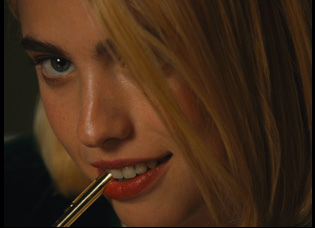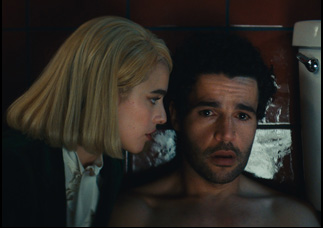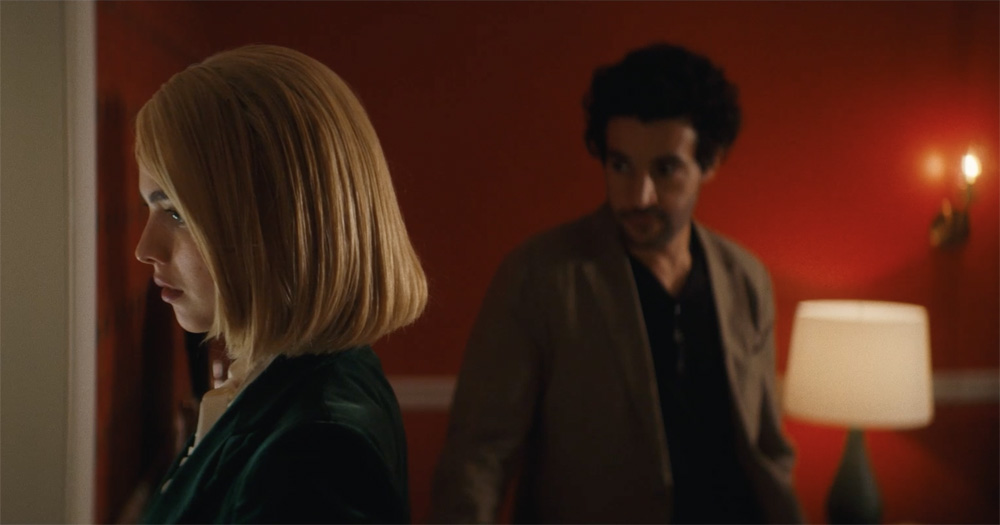Sometimes it can be a chore to sift through screenplays, looking for a next project when all you really want to do is be on set, but for Ludovica Isidori, it’s become one of her favorite parts of the process.
“It gives me the chance to read so many scripts, and I love reading stories. I read scripts and my mind starts working just because it starts imagining the movie that I would like to watch,” says Isidori. “It’s quiet, but it’s big, and then I meet so many directors that just enlarge my view of life.”
The same could be said of Isidori, who has shown an ability to broaden the canvas for any filmmaker she’s worked with as a director of photography, quite literally stretching the frame at times to its maximum potential but opening up the possibilities of it as well. After making an immediate impression with her work on Shatara Michelle Ford’s “Test Pattern,” in which the director and DP collaborated to devise of a color palette absent of red until the aftermath of a traumatizing sexual assault, Isidori bathes her latest film in burgundy, both to set the scene for the regal world that Hal (Christopher Abbott), the heir to a hotel fortune, and Rebecca (Margaret Qualley), the dominatrix he’s asked to come up to his high-rise, are operating in and as warning signs that they struggle to heed when Hal tries to end their professional relationship, yet both realize there are lingering personal attachments that are much more difficult to undo.
In director Zachary Wigon’s wicked battle of wits that rarely leaves the room where Hal delivers the unfortunate news to Rebecca, things may never appear what they seem to the two, both operating under the delusion that the fantasy they engage in doesn’t involve them intimately to some extent, but Isidori doesn’t miss a thing with the camera, which becomes as playful as the performers in front of it as they work out the reality of their relationship. Whether toying with whether the hold the camera or place it on a steadying jib to capture Rebecca and Hal’s fragile state of mind or executing long takes that may impress in their dexterity but more so when reflecting a character’s line of thought upon gaining some clarity for themselves, Isidori and her crew add both sensitive insight and explosiveness to the chamber drama, somehow getting at an even bigger picture for the characters than David Lean’s preferred 2.39:1 aspect ratio will allow. After the film first steamed up screens at last year’s Toronto Film Festival, “Sanctuary” has been opening up across the U.S. and recently, Isidori spoke about how she found her calling, her exquisite work on her latest film and the collaborations she treasures on a film production.

I loved it because it’s brilliant, it’s fast, it’s witty, it’s dark and it was a super fast read, and when I met with Zach, it was like professional love at first sight. We just clicked, and it’s funny because it was the first time that I had a pitch meeting and it felt like he was pitching himself to me more than the reverse. I was like “Wait, what’s going on?” And the appeal was Zach because within the first 10 minutes, he was like, “Okay, Ludo, I know it’s two people in a room, and I know we’re coming out of pandemic where a lot of movies were done within contained space with a very limited amount of actors, but I don’t want this to be a pandemic movie. I want this to be cinematic and we’re going do this together” and the very first thing [that appealed to me about] the script was he had a rhythm that was so different from everything I’ve read. So it wasn’t like, “Oh, we’re doing this again.”It was like, “How can we explore this? How do we make it into something that is entertaining and allows people to forget that we’re just in the same room?”
The film announces itself as this big cinematic experience just within the wide frame. Was that an exciting canvas to work on?
We decided for 2.39 [ratio] because we had this idea of changing lenses throughout the movie, so we start in anamorphic, we go into spherical, and then we go back to anamorphic for the very end and the wide screen was what these lenses have in common. It’s definitely about these two people, but there’s a lot of moments where it’s about being aware of everything else in the room because it’s a power play. It’s like you’re playing chess and you need to be aware of your enemies’ move three moves ahead, so it’s this hyper awareness of [how] this character exists but in a very specific space and the way they move and the way they cross [one another], being together in a frame.
It seems like a lot of the color and the way the rooms would be lit was embedded into the production design. What were those early conversations like?
Yes, production design was fundamental and Zach and I spent a lot of time with the production designer, and the nuances were there since early on, but once you see [the set] – and you don’t just see a room in real time, but you also see them in context, because they’re [scenes] go from one room to another to another so [how] our colors contrast or are in conversation with each other meant a lot – Zach and I would walk [around] at the end of every day, checking the color of the tiles in the bathroom and [we’d have these] conversations, “Can we make this dark rather than a classic white bathroom? Is there wallpaper? What’s the tapestry in the background? Are there like things we can play with?” That’s the advantage of building [a set], you have control over it. And we knew from very early on that color was going to play a part emotionally, not just [simply] being there.
And with lamps, like you see the movie, there’s a part where certain lamps actually get broken, so that was like a big part of my conversation with them in terms of how do I motivate a lighting that is changing? Part of it was narrative because some fixtures literally get smashed, but that also informed blocking because obviously it was the practicality of if this lamp is here, can the actor actually break it, but also will it make sense for this room to get darker, considering the scene when it’s going to take place? So it was like a matryoshka, a Russian doll. Every conversation opened up another and another and the art team was phenomenal. They were very, very open to meet our needs and even though it was a smaller movie with limited resources, like indie movies are, I think everyone was in love with the story and had a deep understanding of the narrative beats and at the end of the day, if you understand them, you can find ways.
Something that that worked on me subconsciously the first time and I was excited to realize the second time was how there’s a lot of movement that’s smooth steadcam or technocrane, but you also have a fair amount of handheld operation. What motivated how you would follow the characters in a scene?
The conversation with Zach at the beginning was basically how do we create a jazz concert [where] we go from piece to piece to piece? Or how do we create a lineup [where] there’s all these different songs, but they make sense together and the one you play now, it’s going to pay off [later] and how [do we] create a punctuation or a rhythm where the camera moves and the camera style changes from micro chapter by micro chapter in a way that either supports the acting or plays with them and becomes like a third character in a way that is organic. We had a remote head for one day, so let’s not make it [sound like] we had a technocrane on stage [for the whole shoot]. But we had Steadicam, we used handheld, we used a dolly, we used whip pans and of course, in a way that didn’t take away from the actors, because you can have like cool camera moves, but if they distract you from the story, they take away from their performance, I don’t do my job right. So it was finding and fine tuning, like how do we make it playful, but always within a balance with them and within their game.
The camera really does accentuate the performances, and I imagine you’re trying as much as possible not to shoot like sides to take them out of the energy of whatever’s going on in the back and forth. Was that fun to think about?
Yes, but was it easy? Sometimes no because there is complex choreography and even though we had the advantage of building [a set], we were modest production and had a location that once it was built was not as flexible, so all of the choreography moved. And the one [take] shot had to be precise camera-wise, actor-wise, and the way we got it was by staying hours after prep for many, many evenings – it was me and Zach with our phones and one day, it was Zach’s brother, one day was his best friend, one day was our [production assistant] and we just rehearsed the first half of the movie or more every night – and once we have the actors, they add their own personal take and movement, but we had to make sure that camera and blocking were actually making sense and they were functioning visually but also emotionally.

That’s the best part. The bigger brushstrokes are there always, but when the actors come in, they bring energy and I think energy informs speed because with camera moves, you can have the blocking done and [know] where the camera is, but the speed, the rhythm, that’s something that you can only figure out once you’re on set because it’s literally responding to the energy that‘s presented to you by the actors. Obviously, I work with a Steadicam operator and I used to be married to one, so I think I’m very good at communicating and understanding the difference between a dolly, a Movi and a Ronin, what they do and when to ask for which tool, but also I’m very good at talking and listening to them because I know there’s an element of physicality that is part of what the operator brings to set, so that dynamic is great.
Usually for indie movies, I’ll operate, but this time I was eight-and-a-half months pregnant, so I literally couldn’t operate some of it because I couldn’t fit the dolly and it was like retraining my brain to do exactly what you’re asking – still feeling the energy that’s on set and capturing all those nuances that you only have the actor’s stamp on it, but by being at a monitor. That was new and I think my operator and I did a very good job. Certain shots, like the sex scene, I was like, “I need to operate this because there’s no way I’m going to be able to explain” – literally, you just need to feel the camera and it really becomes an extension of your body. There’s something fluid and physical, almost like your flesh. How do you explain to someone what it means to be in your own body? You don’t, you just be.
Admittedly, this is where I’m out of my depth since I ask from an artistic standpoint, not a technical one, but was there an attraction to a certain type of camera on this?
We tried a few things. We thought about shooting large format and then we realized that we needed something slim, so we went with the Alexa Mini and I’ve worked with it for many, many years, so for me, it was like second nature. It’s a small camera, but beautiful in the way it gives skin tone and we thought it was a very versatile tool that we can shape in whichever form we wanted. In terms of lenses, we knew we wanted anamorphic at the bookends and then spherical in the middle. We tested a few, and Zach especially fell in love with the Cooke anamorphic. He saw them and was like, “Oh my God, Ludo, these are so good.” And sometimes that instinctual reaction that you cannot explain and that’s why every time I’m testing for a movie in conversation with the director, I’m like, “I can talk to you about lenses for days, but you need to come and watch them. There’s no other way.” Like what you’re saying, you come from an artistic point of view, not a technical one and it’s like, yes, there’s a lot of technical things that we need to know, but that’s not the place to make decisions from, so it’s necessary to include directors in that experience because it’s an instinct. For “Test Pattern” with Shatara, it was the same. We tested a bunch of glasses at Panavision, and she was like, “These.” And I’m like, “Okay.” [laughs] I will fight back if I’m very against it, but in both cases that was the movie calling for it, so let’s do it.
What’s it been like seeing this one out in the world?
It’s incredible. Just seeing my work in theater gives me this infinite joy. Yesterday I went to the Angelika to watch a different movie and as I’m walking in with my partner, we were talking about “Sanctuary” and behind us, a mother and a son overheard, and they told us like, “Oh, ‘Sanctuary,‘ that was great. We watched it last week. It was fantastic.” And I was like, “Yeah, I shot that.” They were like, “Oh, wait, what?” And I’m just grateful that Zach took me in and I’ very proud of it. It was an incredible experience and it’s being distributed and released right now in Italy, which is where I’m from and it’s screening in a theater in my own town, which is super random because it’s a small town, but it’s like, “Hey, I left 12 years ago because of this. This is what I do and this is the dream that I followed.”
How did you end up getting into this line of work in the first place?
I don’t know if I have an answer for you, meaning I come from a family of doctors, so I was supposed to go to med school, but I wasn’t really sure what I wanted to do when I was 18. [In Italy] that’s easier, because you don’t have to pay hundreds of thousands of dollars for education, so you can take your time to find things out. I’ve always loved going to the movies and my mom brought me since I was five years old, so I always had a love for cinema and storytelling. The camera [specifically] came to me because at some point during my studies, my boyfriend at the time was a very self-centered dude and wanted to make shorts and be it all. He was the artist, so there weren’t a lot of places left, but the camera was one of those, so I said, “Sure, I can be behind the camera. I don’t need the spotlight.” And then I started to realize like the magic of it – when everything gets quiet and it’s not about politics, you’re behind the camera and you’re the first audience. It just gives me goosebumps.
Becoming a DP, there’s so much more to it because you also need to be a good leader for your crew because they need to follow you and you need to take care of them, so you need to manage power in a way that you can’t have power trip. That’s not it. It’s about listening to other people, and I’m lucky. It’s the best job in the world and it’s the people. When you meet people like Shatara and Zach, they’re artists, they have a vision, they have a voice and they still have space for you to get along with them and bring things on. That’s the magic. There’s nothing else.
“Sanctuary” is now in theaters.




